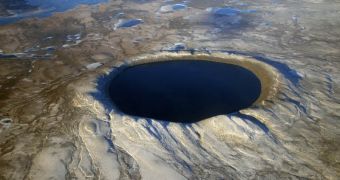A new research by researchers at the Open University, in the United Kingdom, suggests that impact craters such as those created by asteroids and comets can become refuges for different life forms, or even a birthplace for life on worlds that are not already populated.
The study showcases how the heat generated by such an impact may contribute to fostering life as we know it.
The first condition experts led by Iaon Gilmour set for their investigation was that the initial impact is not strong enough to cause a global cataclysm. In other words, if the asteroid is not large enough to kill everything on a planet, then it may contribute to promoting the diversification of life.
In a presentation made at the European Planetary Science Congress this September, the team explains that an impact occurring in an ice- or water-rich region of a planet would most often lead to the creation of a hydrothermal system, as well as to the synthesis of many complex organic compounds.
Therefore, this combination of elements would create the right conditions for the development of life. The main implication of this study is that impact craters may have the origin of life on Earth.
Factors that may reduce the chances of life developing in a crater include a short lifespan for hydrothermal system, as well as limited supplies of liquid water and nutrients. So the team focused on measuring the heating timescale of an important structure, the Boltysh crater in the Ukraine.
The thermal history of the crater was reconstructed by analyzing layers of deposit underneath the lake that now occupies it. The team drilled a 596-meter (1,955-foot) borehole in the 24-kilometer (15-mile) crater, and was able to recover sediment layers spanning about 65 million years.
The team learned that the hydrothermal system formed after an asteroid created this crater lasted between 30,000 and 40,000 years. Additionally, the heating time was found to have been extended by the quick formation of the lake in the crater, Astrobiology Magazine reports.
“The cooling timescale, at 30,000 to 40,000 years, is not that long when one considers that after it's cold then it may not remain a viable habitat. The question then becomes one of cratering flux on early planets and whether that flux is enough to create interlinked habitats, but not so great as to potentially wipe out life,” Gilmour explains.
This study could have important implications for our search of life on other planets, such as Mars. Craters similar to Boltysh can be found in abundance on the Red Planet, and astronomers also know that the world contains vast amounts of water, now stored as ice.

 14 DAY TRIAL //
14 DAY TRIAL //